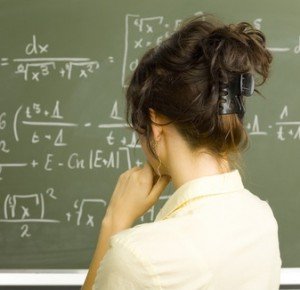American researchers who say gender equity and other sociocultural factors — not national income, school type, or religion — determine mathematics performance at all levels for both boys and girls suggest there’s little “gender gap” among younger NZ schoolchildren, but it’s quite noticeable in older classes.
 The new research, Debunking Myths and Gender Performance fingers culture as the culprit, and identifies countries rated as female-maths-friendly as having more gender equality, better teachers and fewer students living in poverty.
The new research, Debunking Myths and Gender Performance fingers culture as the culprit, and identifies countries rated as female-maths-friendly as having more gender equality, better teachers and fewer students living in poverty.
“This is not a matter of biology: None of our findings suggest that an innate biological difference between the sexes is the primary reason for a gender gap in math performance,” researcher Janet Mertz, of the University of Wisconsin-Madison, said in a statement. “The math-gender gap, where it occurs, is due to sociocultural factors that differ among countries, and that these factors can be changed”.
Part of the research was based on the International Mathematics Olympiad (IMO), where New Zealand included just 19 girls among the 144 students it has sent to 24 competitions since 1988, but Dr Mertz told the SMC that earlier analysis of olympiad participation showed “NZ actually has done quite well with respect to participation by girls in the IMO. “Anything above about 10 percent is outstanding for participation by girls in the IMO prior to recent years. By comparison, the USA has had only 5 girls participate since 1974, with none prior to 1998”
She said her latest research showed why it was wrong for some previous researchers to say the the World Economic Forum’s “gender gap index” (GGI) reflecting economic and political opportunities, education, and well-being for women did not their correlate with the percentages of girls on IMO teams.
“In the US and Canada, about half of the members of IMO teams are children of immigrants from other countries that excel in the IMO (i.e., certain Eastern Europe and East Asian countries),” said Dr Mertz. She was not able to give a comparison for NZ but noted many participants from this country had Asian surnames, which “suggest cultural differences even among children educated in the same country”.
The study analysed data from two international surveys of school mathematics performance, one from 2007, which included fourth-graders (Standard 3 or Year 5) and eighth-graders (Form 3 or Year 9), and the other from 2009, which included 15-year-olds. The data from some of the 86 countries showed greater variability in male math talent only in some cultures, such as Taiwan, while in Tunisia, girls showed more variability — pointing a finger at culture, not biology as a key factor.
New Zealand did not participate in the 2007 Trends in International Mathematics and Science Study (TIMSS) for 8th graders (Year 9 in NZ), the exam on which the new paper focused, but did take part in other exams the researchers analysed, including the 2003 TIMSS for 8th graders.
“In 4th and 8th grades, New Zealand does not have a gender gap in mean math performance while Australia has a small one, but the New Zealand kids are not doing as well in maths as are the Australian kids. However, by age 15, the New Zealanders have slightly overtaken the Australians in maths performance, with both countries having a small gender gap. The 2009 GGI ranks for New Zealand and Australia were 5 and 20, respectively,” said Dr Mertz.
Included below is some example data from the studies examined by Dr Mertz and her colleagues. Values represent mean scores on exams with 500 set as the benchmark mean.
| 2009 Programme for International Student Assesment (15 year olds) | |||
| AUS | NZ | ||
| Boys | 519 | 523 | |
| Girls | 509 | 515 | |
| 2007 Trends in International Mathematics and Science Study (Year 5 students) | |||
| AUS | NZ | ||
| Boys | 519 | 493 | |
| Girls | 513 | 492 | |
| 2003 TIMSS (Year 9 students) | |||
| Boys | 511 | 493 | |
| Girls | 499 | 495 | |